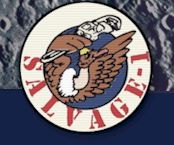Estes Vulture Model
Rocket

Side View |
Did
you build and fly model rockets when you were young? If Salvage 1 had
been more popular, you might have been flying the show's spaceship, the
Vulture! Michael Hellmund made the remarkable discovery of a prototype
that would have been the Estes Vulture. Michael worked at Estes
from 1991 to 1997. He explains how he made this wonderful find:
"The story of how I got
this model is rather sad. The house that used to be the home of the
Estes' founders, Vern and Gleda Estes, became the R&D House
after Vern sold the company. When Estes was sold again to it's current
owners, the new management moved the R&D staff to the main
office building at Estes. The house was largely abandoned and became
cold storage for bits and pieces. Eventually Estes, because of
insurance reasons (the house was too close to the Engine making
facilities), had to either have the house moved or demolished. The
house was sold and moved."
 Capsule
Capsule |
 Note
engine mount
Note
engine mount |
"Before it was moved, the house was cleaned
out. Many items (photos, decals, parts, pieces of models -- many items
with model rocket historical value), were simply thrown out. I managed
to salvage (pardon the pun in this context) some items and this model
of the Vulture was one.""It seems that this was a boilerplate, possibly
a flight model that Estes R&D created. I am guessing that it
was made in the fall of 1977 (or in the fall of when the series debut
on TV). It is approximately 12" long. It is missing a few pieces and
one of the landing legs is damaged. There is quite a bit of detail that
is not on this model. Having worked at Estes and knowing a bit about
model rocket development, I think that a lot of details were omitted
for 1) cost (if this ever had made it in to kit form), 2) ease of
building and 3) making it as flight worthy as possible play into mind."
 Top
View
Top
View |
 Another
side view
Another
side view |
 Closeup
Closeup |
"The slots you see in the side of the body
tube are probably for clear fins so that it would be stable for model
rocket flight. I think the ladder and hatch details would have been
added with decals. The parachute would have come out of the top, blue
cone. The model is largely made of paper tubes and balsa nose pieces.
The nozzle bells came from a Saturn V kit (I think 1/100 kit -- Estes).
I do not think this flew but with the addition of the removable clear
fins it should do nicely."
A special thanks to Michael Hellmund for sharing this find and for
providing the pictures you see on this page. He intends to build a
clone of the model someday and eventually you may find some plans on
this page. As an old rocketeer myself, I have to say that this would
have been one of my favorite rockets of all time if it had been
produced.
If only. |









